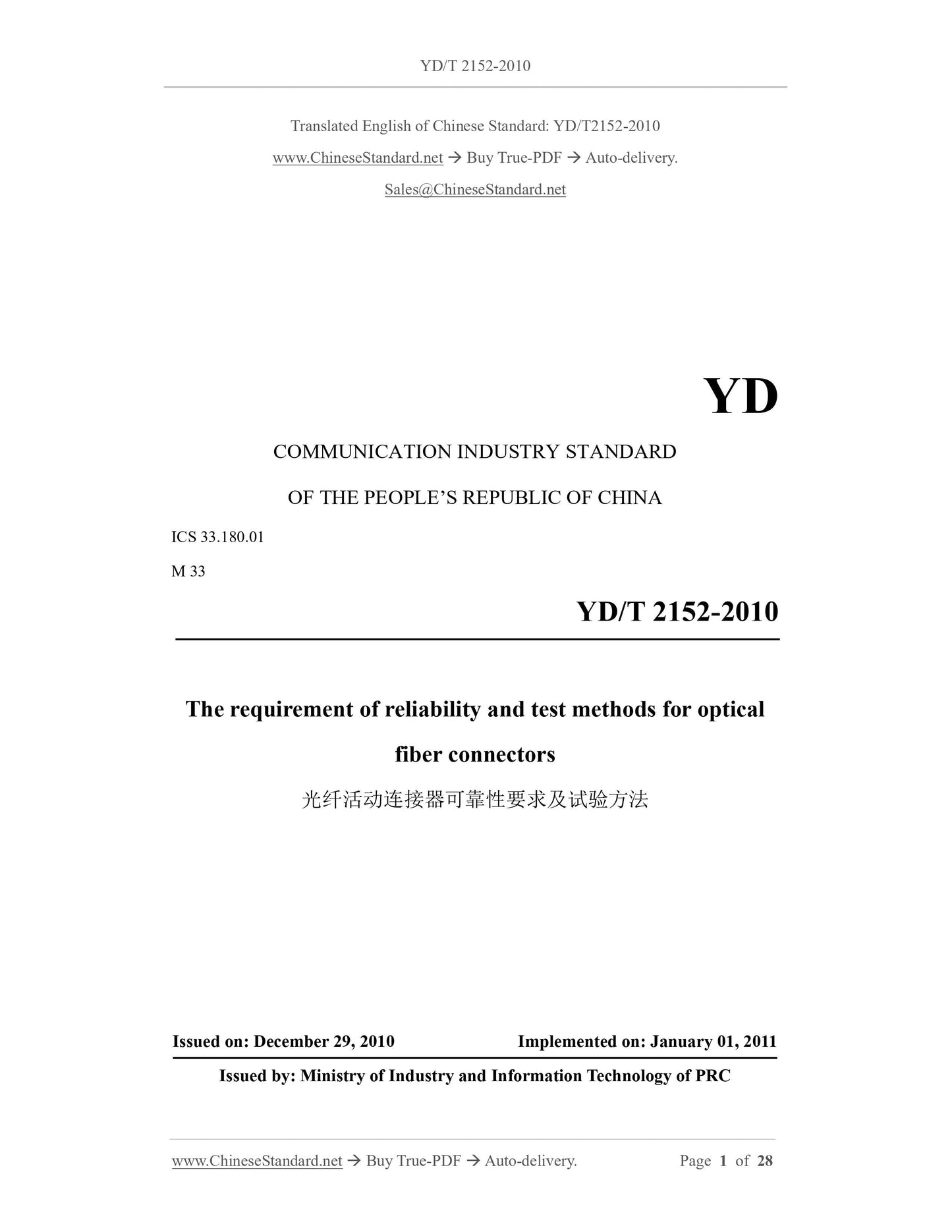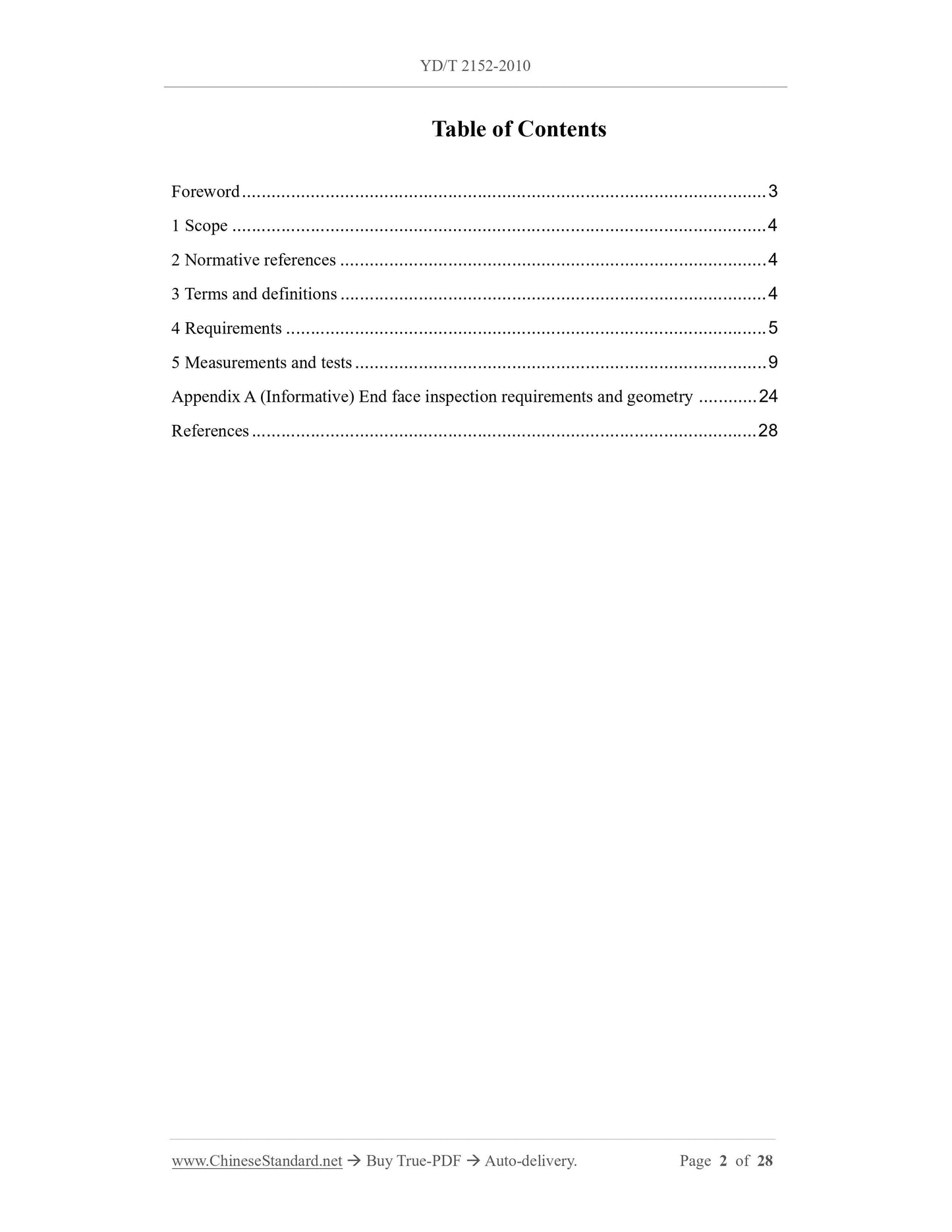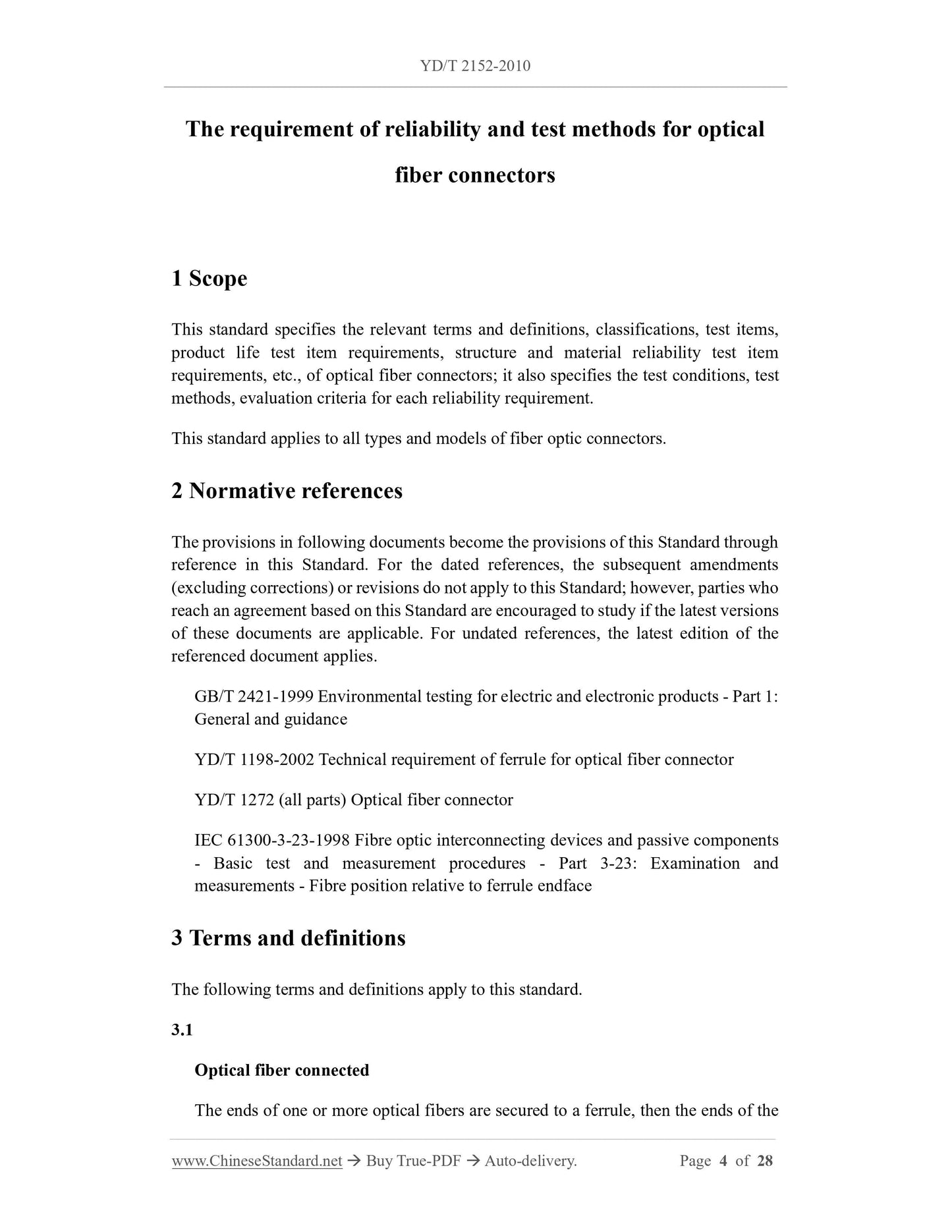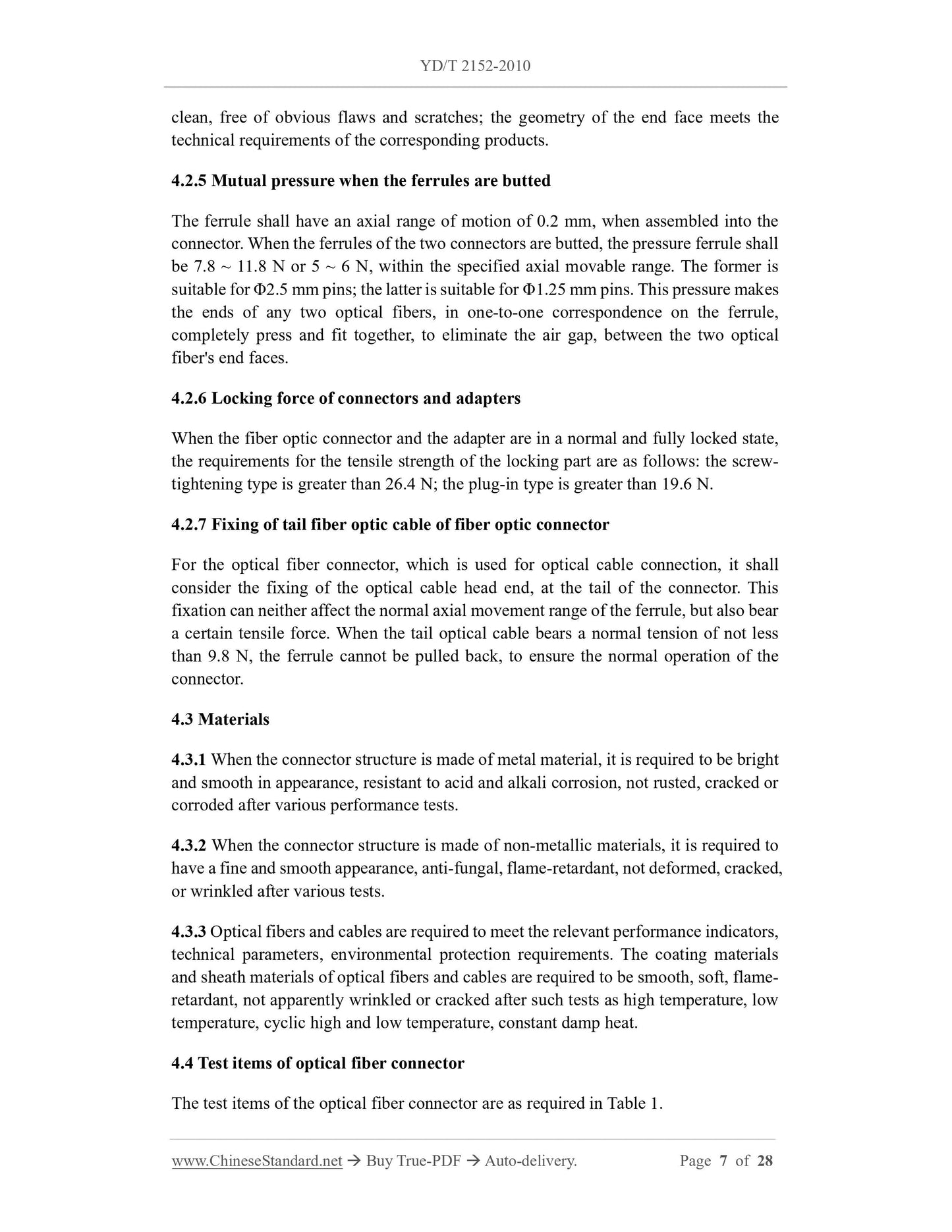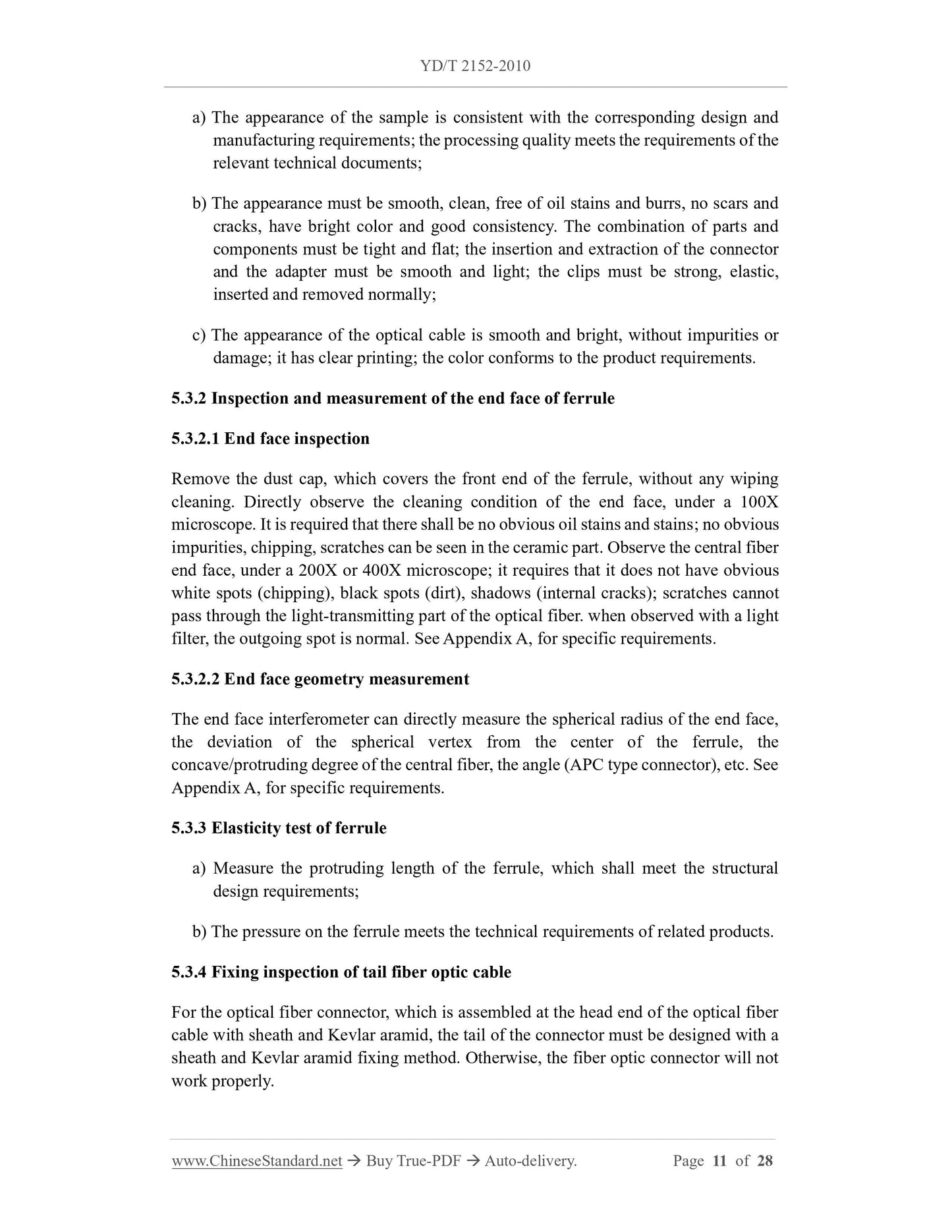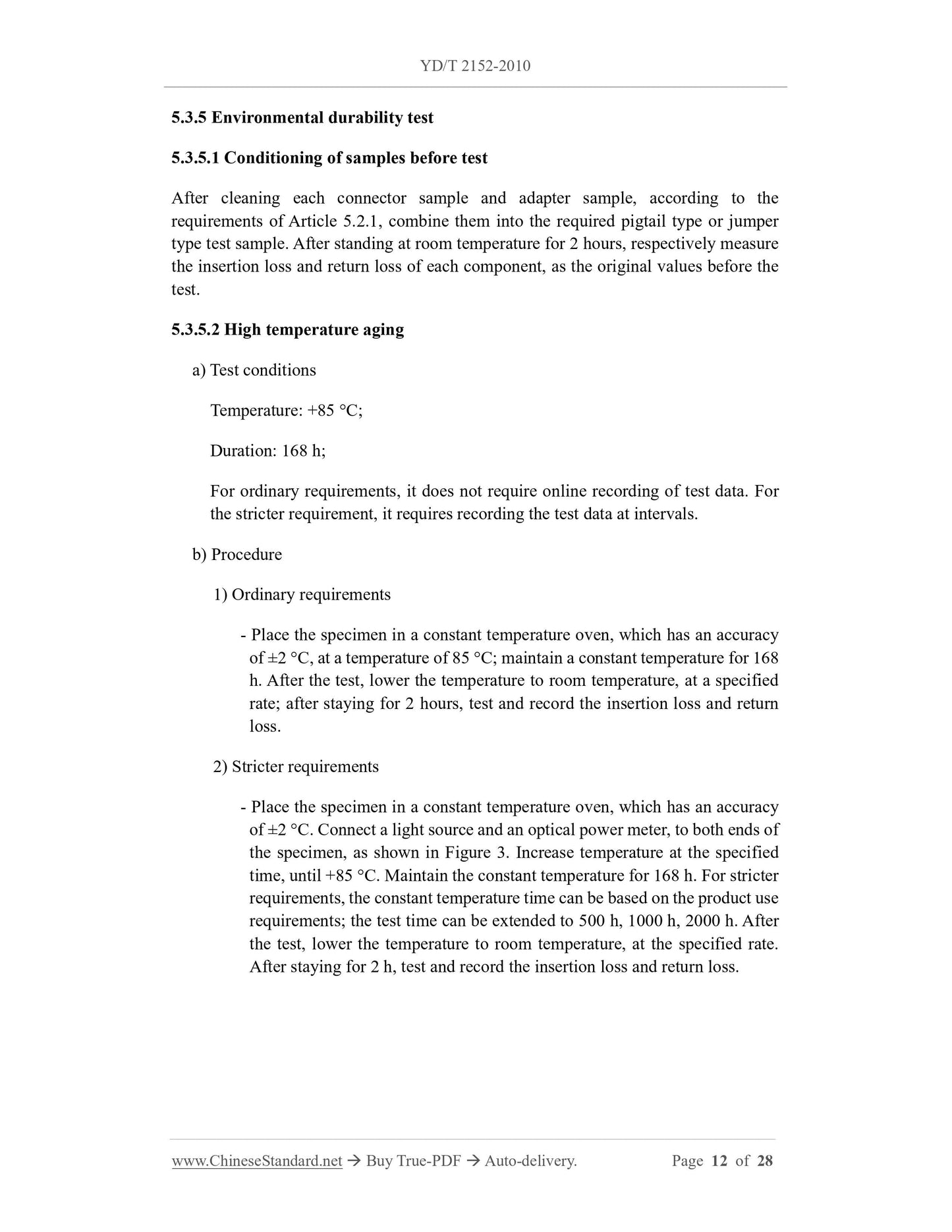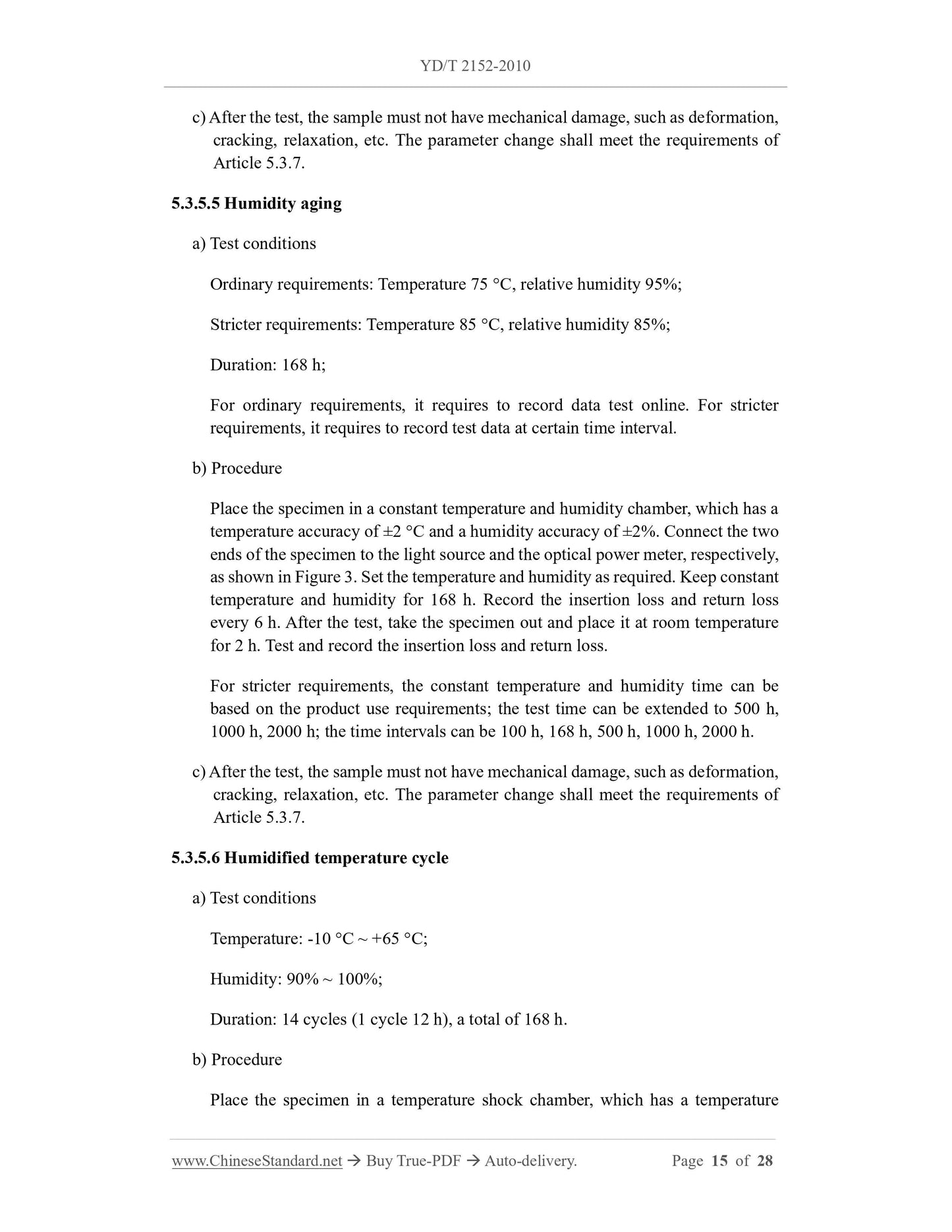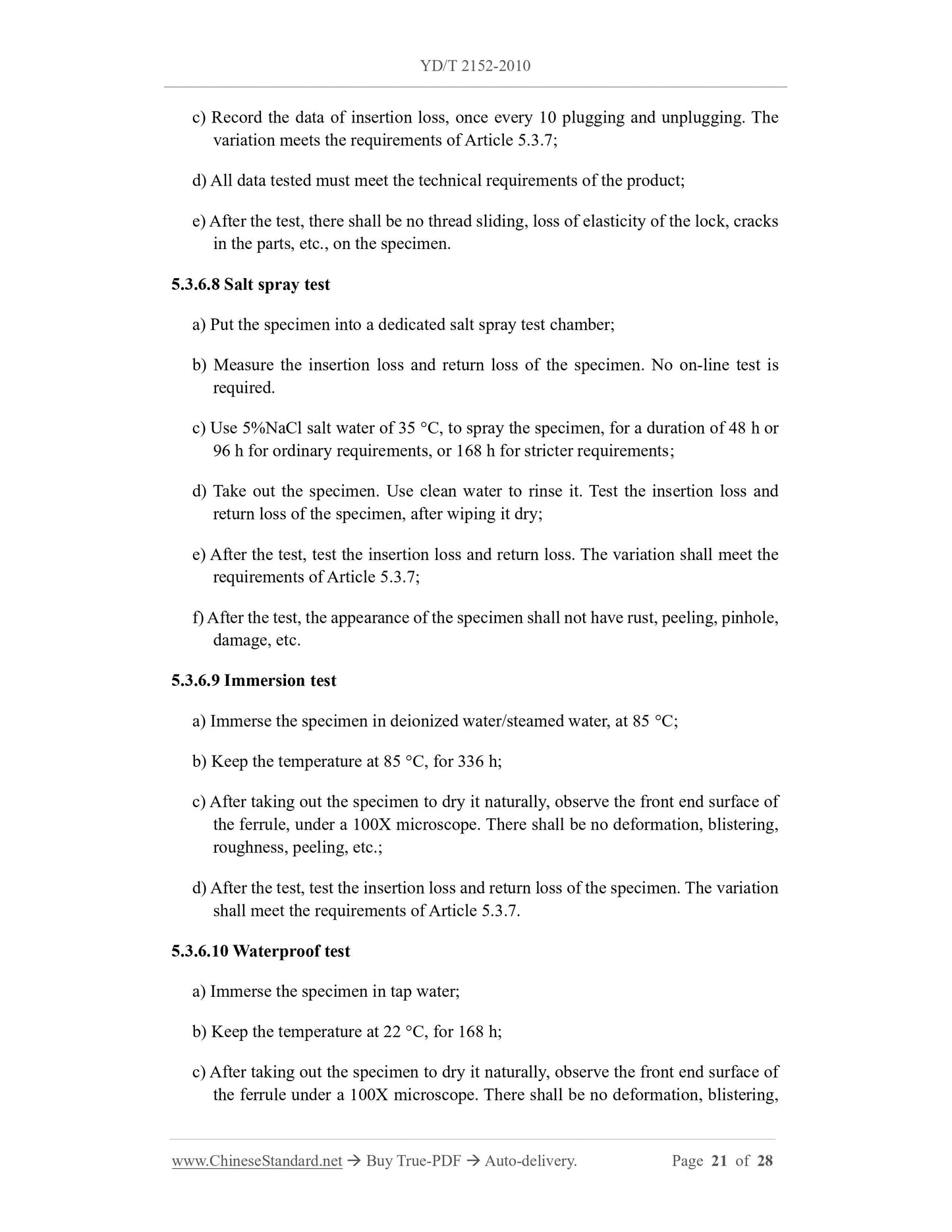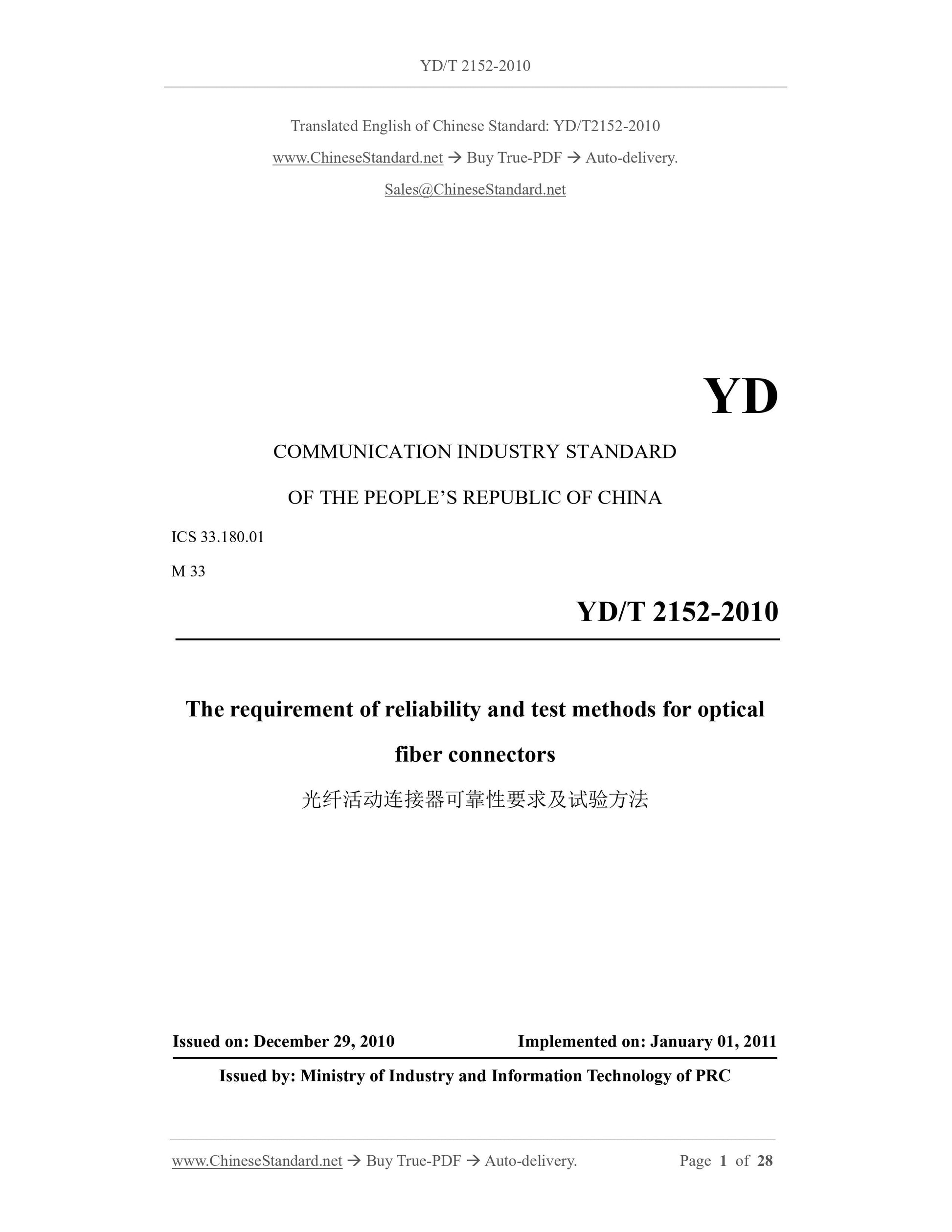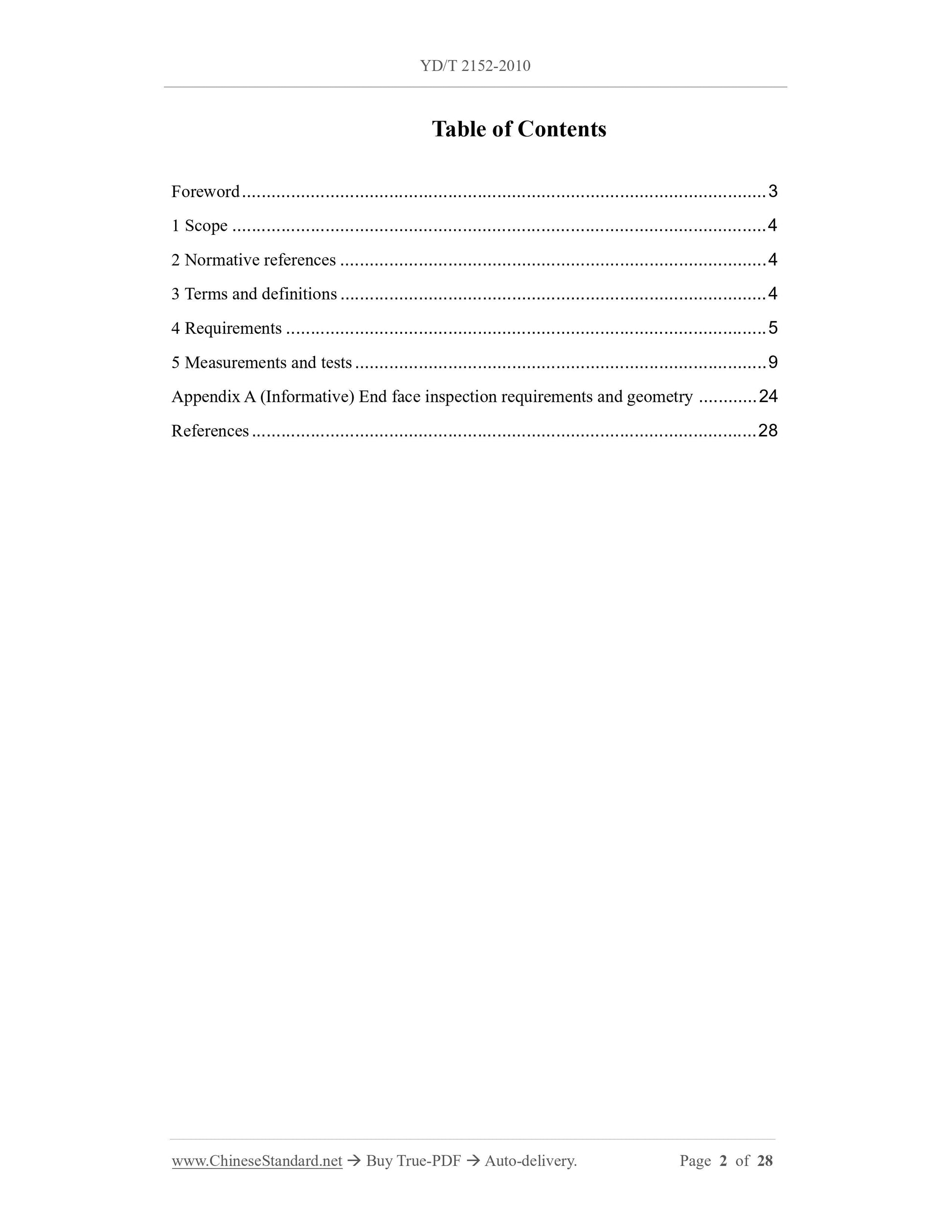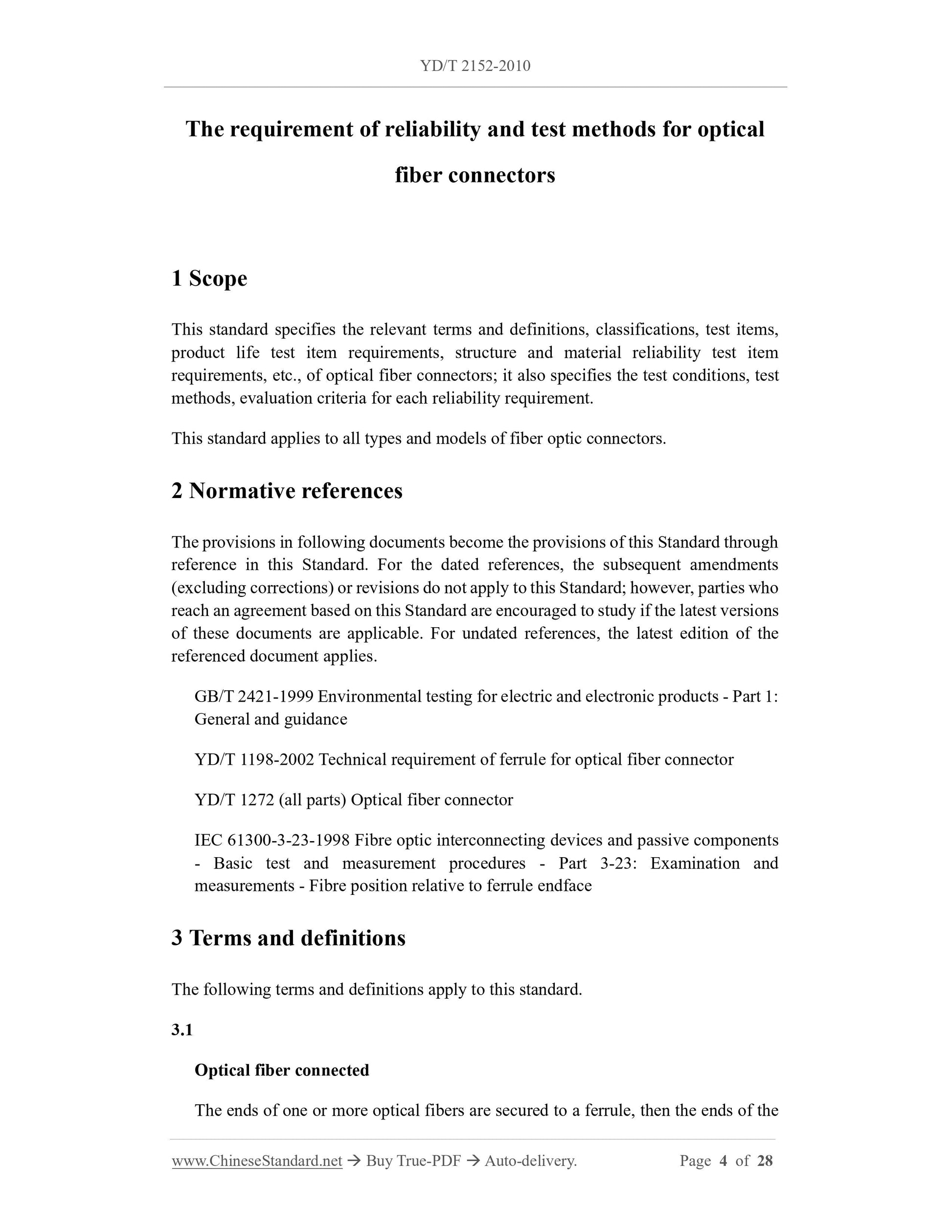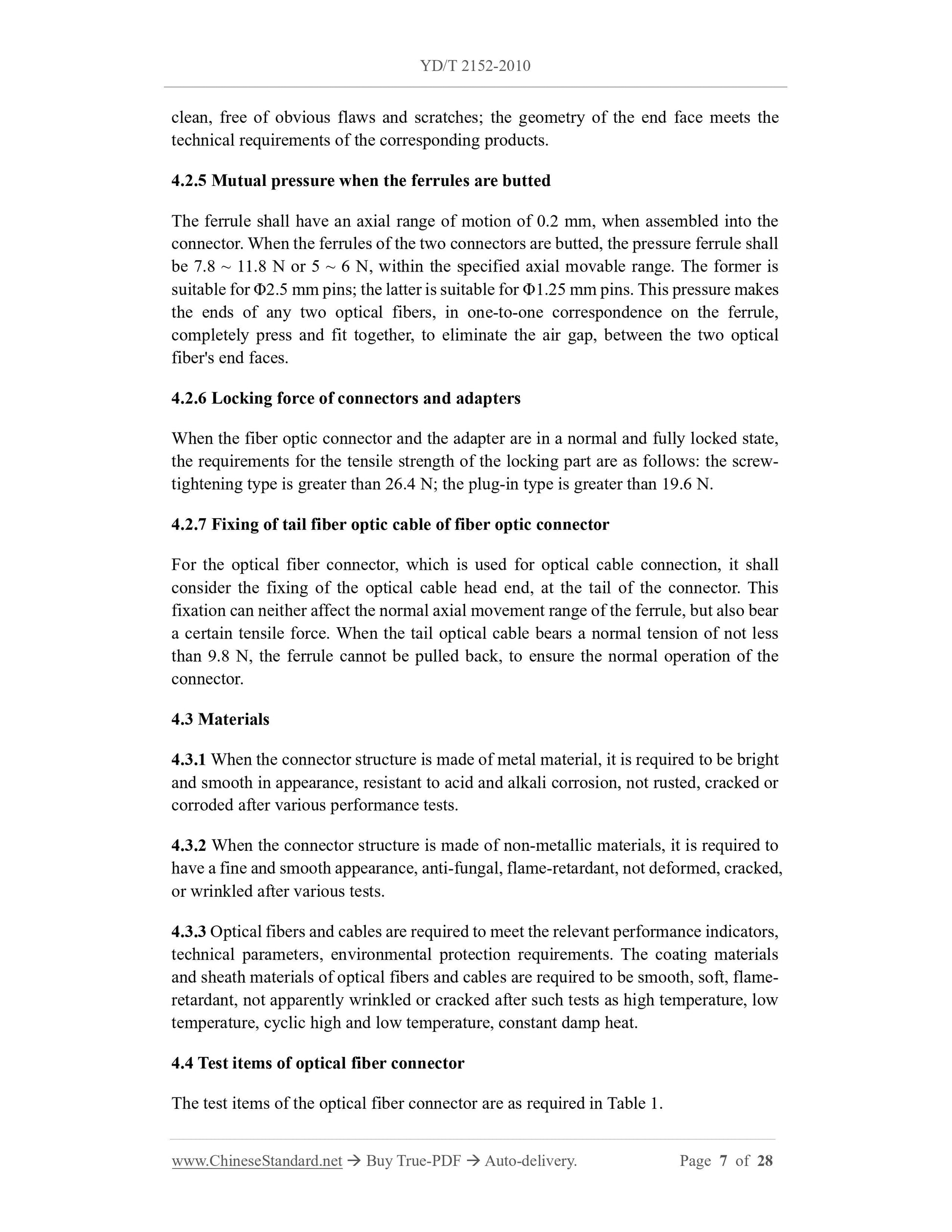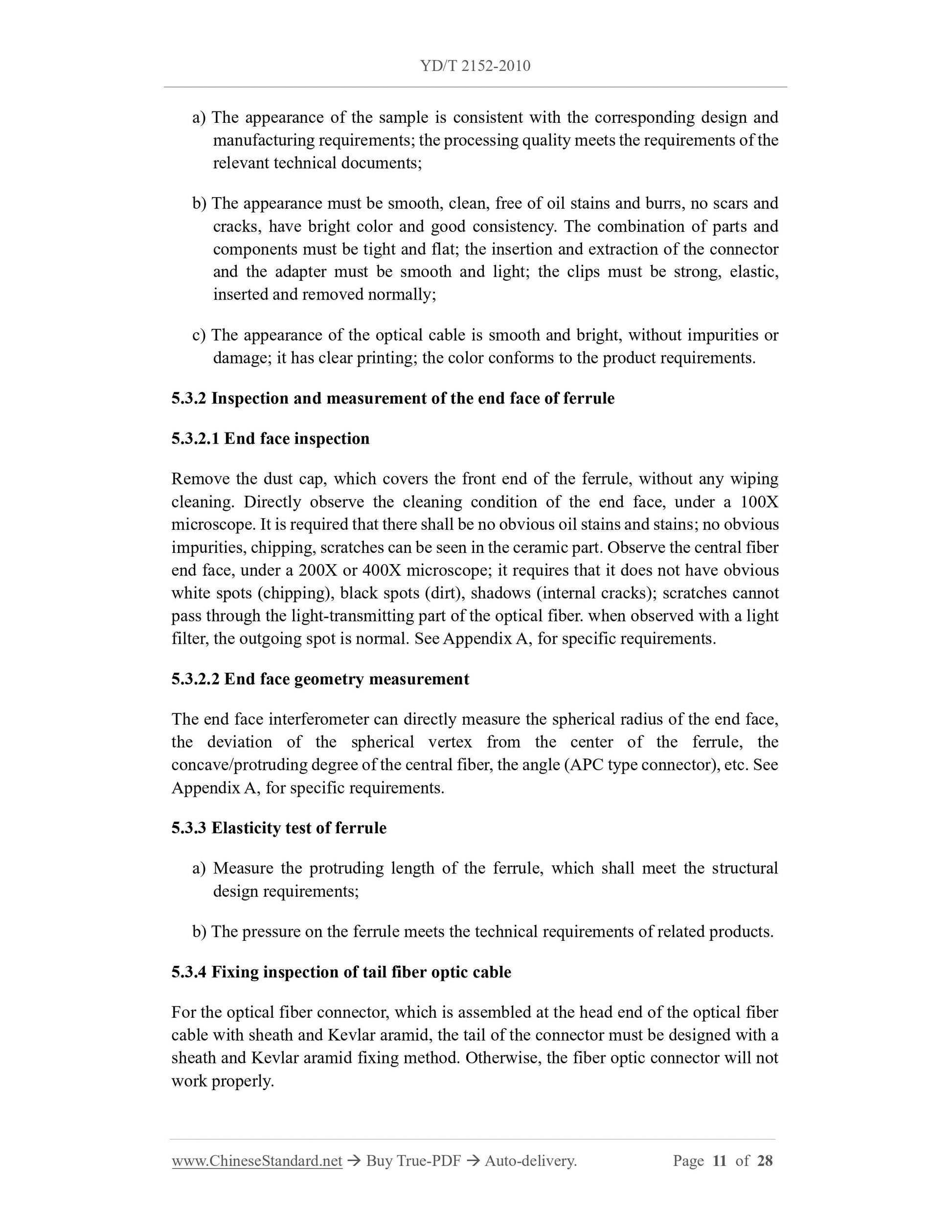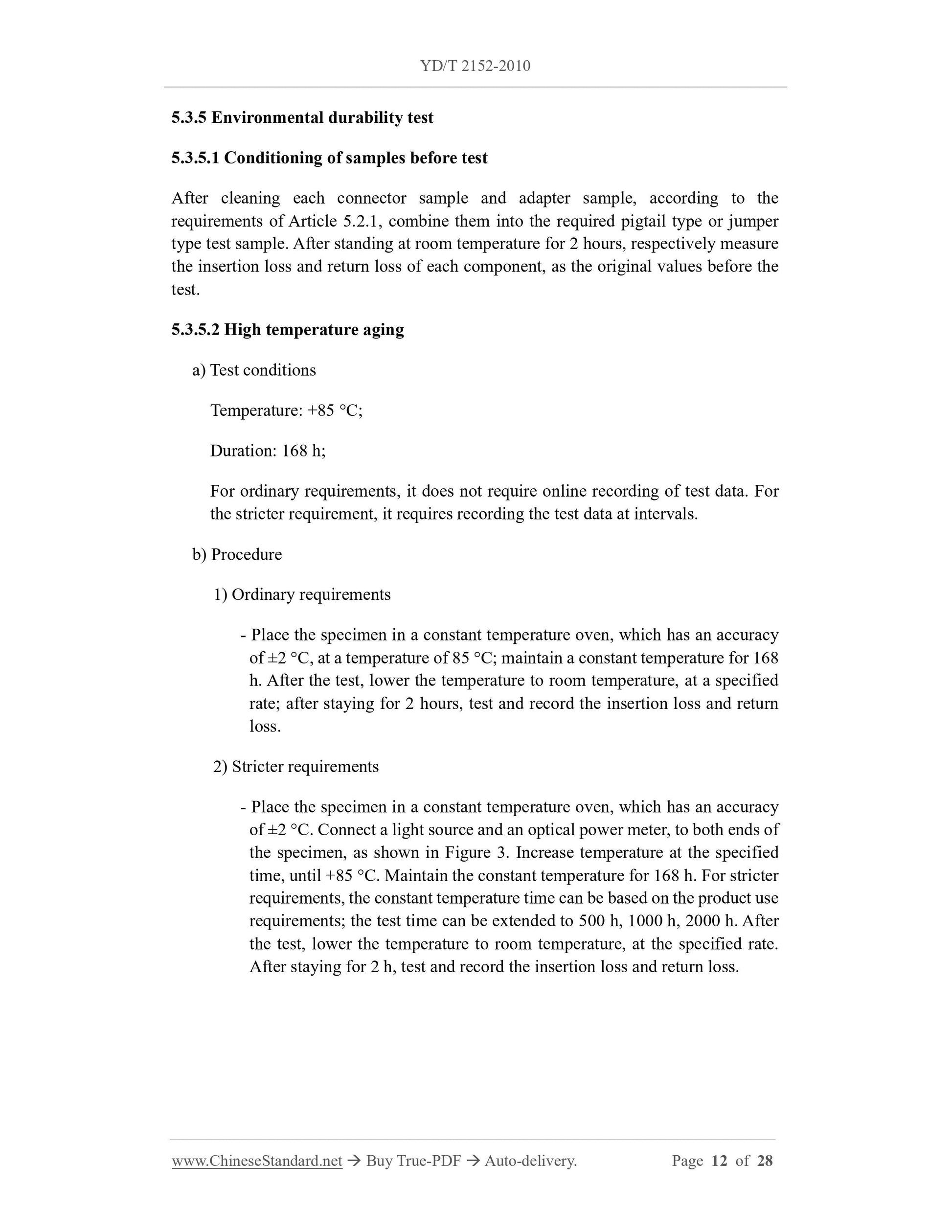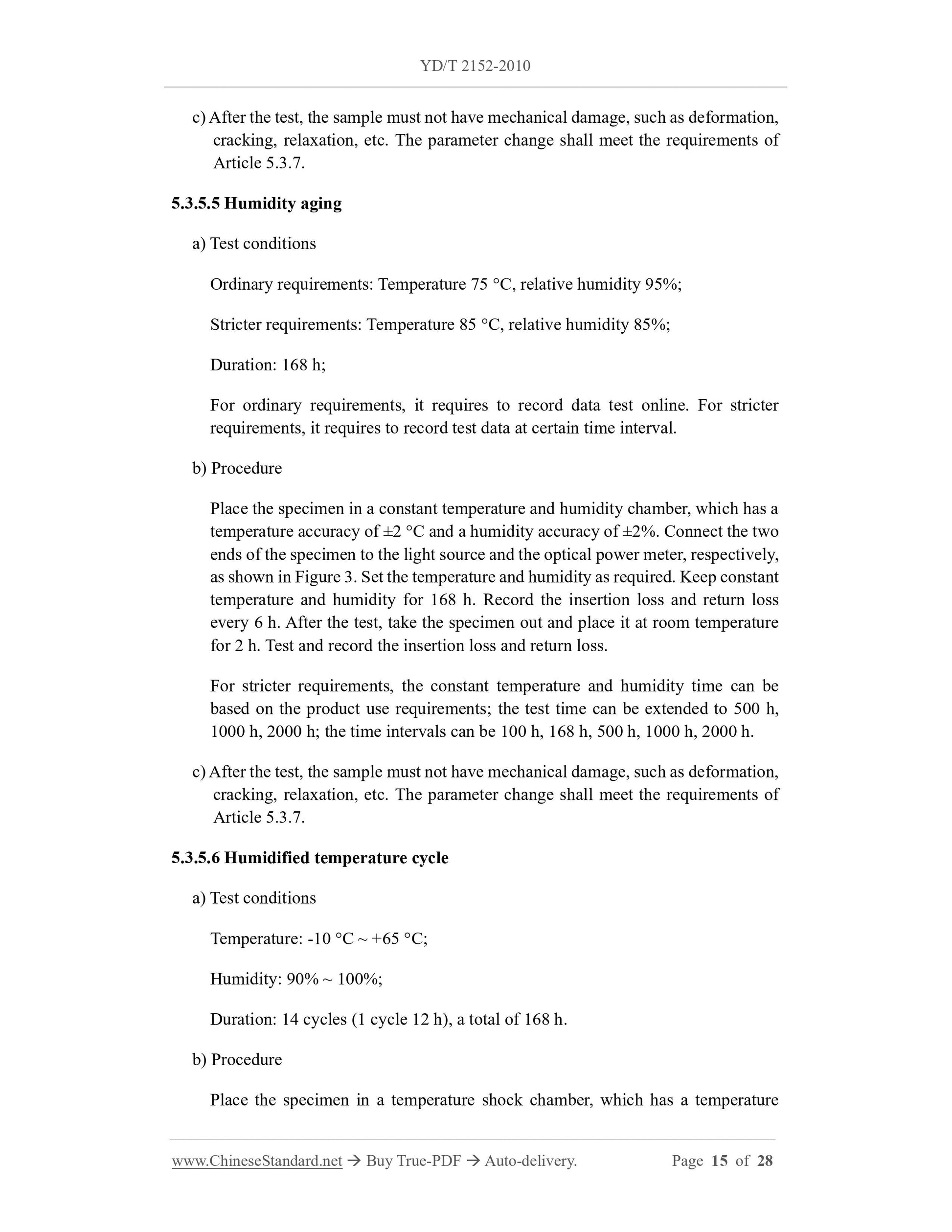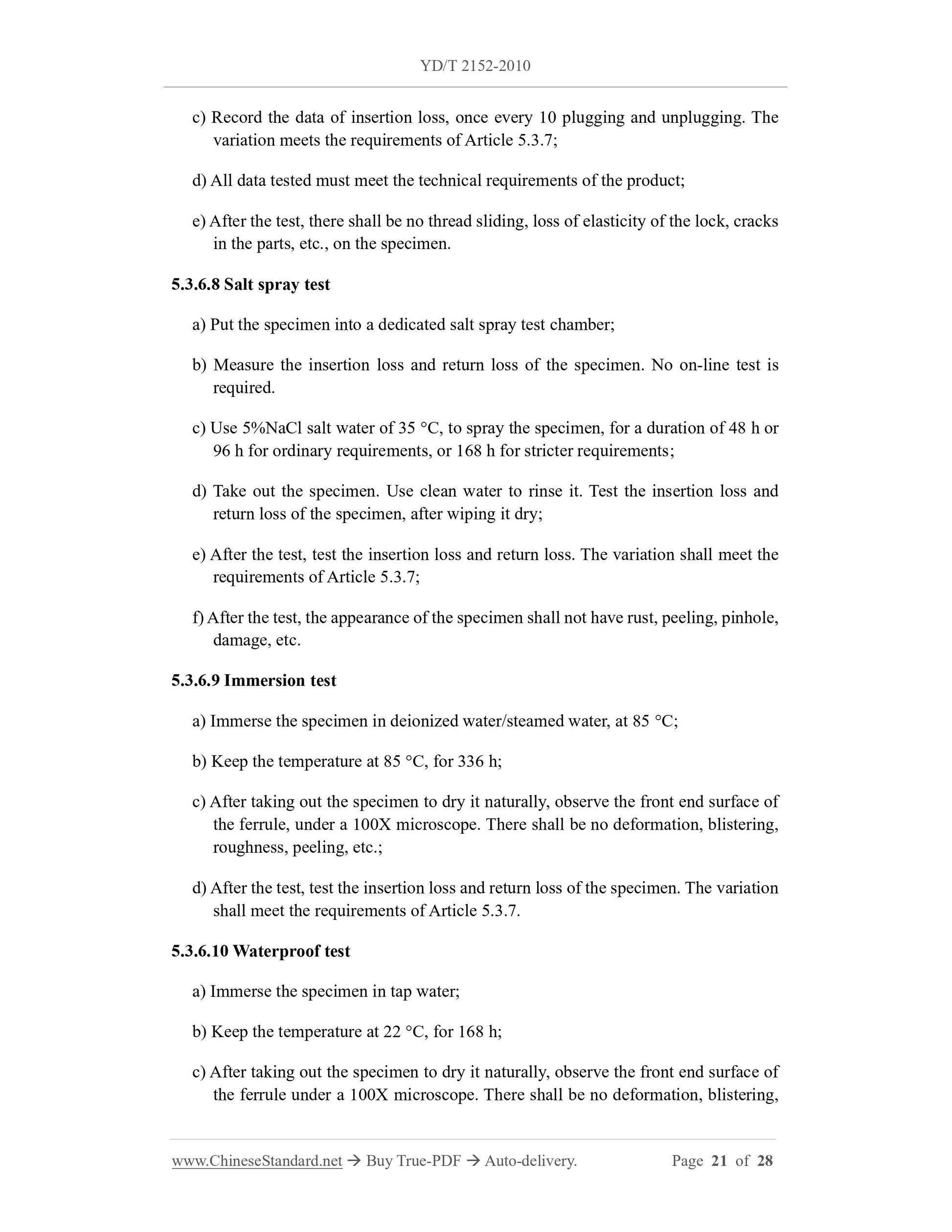1
/
of
8
PayPal, credit cards. Download editable-PDF and invoice in 1 second!
YD/T 2152-2010 English PDF (YDT2152-2010)
YD/T 2152-2010 English PDF (YDT2152-2010)
Regular price
$280.00 USD
Regular price
Sale price
$280.00 USD
Unit price
/
per
Shipping calculated at checkout.
Couldn't load pickup availability
Delivery: 3 seconds. Download true-PDF + Invoice.
Get QUOTATION in 1-minute: Click YD/T 2152-2010
Historical versions: YD/T 2152-2010
Preview True-PDF (Reload/Scroll if blank)
YD/T 2152-2010: The requirement of reliability and test methods for optical fiber connectors
YD/T 2152-2010
YD
COMMUNICATION INDUSTRY STANDARD
OF THE PEOPLE’S REPUBLIC OF CHINA
ICS 33.180.01
M 33
The requirement of reliability and test methods for optical
fiber connectors
ISSUED ON: DECEMBER 29, 2010
IMPLEMENTED ON: JANUARY 01, 2011
Issued by: Ministry of Industry and Information Technology of PRC
Table of Contents
Foreword ... 3
1 Scope ... 4
2 Normative references ... 4
3 Terms and definitions ... 4
4 Requirements ... 5
5 Measurements and tests ... 9
Appendix A (Informative) End face inspection requirements and geometry ... 24
References ... 28
The requirement of reliability and test methods for optical
fiber connectors
1 Scope
This standard specifies the relevant terms and definitions, classifications, test items,
product life test item requirements, structure and material reliability test item
requirements, etc., of optical fiber connectors; it also specifies the test conditions, test
methods, evaluation criteria for each reliability requirement.
This standard applies to all types and models of fiber optic connectors.
2 Normative references
The provisions in following documents become the provisions of this Standard through
reference in this Standard. For the dated references, the subsequent amendments
(excluding corrections) or revisions do not apply to this Standard; however, parties who
reach an agreement based on this Standard are encouraged to study if the latest versions
of these documents are applicable. For undated references, the latest edition of the
referenced document applies.
GB/T 2421-1999 Environmental testing for electric and electronic products - Part 1:
General and guidance
YD/T 1198-2002 Technical requirement of ferrule for optical fiber connector
YD/T 1272 (all parts) Optical fiber connector
IEC 61300-3-23-1998 Fibre optic interconnecting devices and passive components
- Basic test and measurement procedures - Part 3-23: Examination and
measurements - Fibre position relative to ferrule endface
3 Terms and definitions
The following terms and definitions apply to this standard.
3.1
Optical fiber connected
The ends of one or more optical fibers are secured to a ferrule, then the ends of the
clean, free of obvious flaws and scratches; the geometry of the end face meets the
technical requirements of the corresponding products.
4.2.5 Mutual pressure when the ferrules are butted
The ferrule shall have an axial range of motion of 0.2 mm, when assembled into the
connector. When the ferrules of the two connectors are butted, the pressure ferrule shall
be 7.8 ~ 11.8 N or 5 ~ 6 N, within the specified axial movable range. The former is
suitable for Φ2.5 mm pins; the latter is suitable for Φ1.25 mm pins. This pressure makes
the ends of any two optical fibers, in one-to-one correspondence on the ferrule,
completely press and fit together, to eliminate the air gap, between the two optical
fiber's end faces.
4.2.6 Locking force of connectors and adapters
When the fiber optic connector and the adapter are in a normal and fully locked state,
the requirements for the tensile strength of the locking part are as follows: the screw-
tightening type is greater than 26.4 N; the plug-in type is greater than 19.6 N.
4.2.7 Fixing of tail fiber optic cable of fiber optic connector
For the optical fiber connector, which is used for optical cable connection, it shall
consider the fixing of the optical cable head end, at the tail of the connector. This
fixation can neither affect the normal axial movement range of the ferrule, but also bear
a certain tensile force. When the tail optical cable bears a normal tension of not less
than 9.8 N, the ferrule cannot be pulled back, to ensure the normal operation of the
connector.
4.3 Materials
4.3.1 When the connector structure is made of metal material, it is required to be bright
and smooth in appearance, resistant to acid and alkali corrosion, not rusted, cracked or
corroded after various performance tests.
4.3.2 When the connector structure is made of non-metallic materials, it is required to
have a fine and smooth appearance, anti-fungal, flame-retardant, not deformed, cracked,
or wrinkled after various tests.
4.3.3 Optical fibers and cables are required to meet the relevant performance indicators,
technical parameters, environmental protection requirements. The coating materials
and sheath materials of optical fibers and cables are required to be smooth, soft, flame-
retardant, not apparently wrinkled or cracked after such tests as high temperature, low
temperature, cyclic high and low temperature, constant damp heat.
4.4 Test items of optical fiber connector
The test items of the optical fiber connector are as required in Table 1.
a) The appearance of the sample is consistent with the corresponding design and
manufacturing requirements; the processing quality meets the requirements of the
relevant technical documents;
b) The appearance must be smooth, clean, free of oil stains and burrs, no scars and
cracks, have bright color and good consistency. The combination of parts and
components must be tight and flat; the insertion and extraction of the connector
and the adapter must be smooth and light; the clips must be strong, elastic,
inserted and removed normally;
c) The appearance of the optical cable is smooth and bright, without impurities or
damage; it has clear printing; the color conforms to the product requirements.
5.3.2 Inspection and measurement of the end face of ferrule
5.3.2.1 End face inspection
Remove the dust cap, which covers the front end of the ferrule, without any wiping
cleaning. Directly observe the cleaning condition of the end face, under a 100X
microscope. It is required that there shall be no obvious oil stains and stains; no obvious
impurities, chipping, scratches can be seen in the ceramic part. Observe the central fiber
end face, under a 200X or 400X microscope; it requires that it does not have obvious
white spots (chipping), black spots (dirt), shadows (internal cracks); scratches cannot
pass through the light-transmitting part of the optical fiber. when observed with a light
filter, the outgoing spot is normal. See Appendix A, for specific requirements.
5.3.2.2 End face geometry measurement
The end face interferometer can directly measure the spherical radius of the end face,
the deviation of the spherical vertex from the center of the ferrule, the
concave/protruding degree of the central fiber, the angle (APC type connector), etc. See
Appendix A, for specific requirements.
5.3.3 Elasticity test of ferrule
a) Measure the protruding length of the ferrule, which shall meet the structural
design requirements;
b) The pressure on the ferrule meets the technical requirements of related products.
5.3.4 Fixing inspection of tail fiber optic cable
For the optical fiber connector, which is assembled at the head end of the optical fiber
cable with sheath and Kevlar aramid, the tail of the connector must be designed with a
sheath and Kevlar aramid fixing method. Otherwise, the fiber optic connector will not
work properly.
5.3.5 Environmental durability test
5.3.5.1 Conditioning of samples before test
After cleaning each connector sample and adapter sample, according to the
requirements of Article 5.2.1, combine them into the required pigtail type or jumper
type test sample. After standing at room temperature for 2 hours, respectively measure
the insertion loss and return loss of each comp...
Get QUOTATION in 1-minute: Click YD/T 2152-2010
Historical versions: YD/T 2152-2010
Preview True-PDF (Reload/Scroll if blank)
YD/T 2152-2010: The requirement of reliability and test methods for optical fiber connectors
YD/T 2152-2010
YD
COMMUNICATION INDUSTRY STANDARD
OF THE PEOPLE’S REPUBLIC OF CHINA
ICS 33.180.01
M 33
The requirement of reliability and test methods for optical
fiber connectors
ISSUED ON: DECEMBER 29, 2010
IMPLEMENTED ON: JANUARY 01, 2011
Issued by: Ministry of Industry and Information Technology of PRC
Table of Contents
Foreword ... 3
1 Scope ... 4
2 Normative references ... 4
3 Terms and definitions ... 4
4 Requirements ... 5
5 Measurements and tests ... 9
Appendix A (Informative) End face inspection requirements and geometry ... 24
References ... 28
The requirement of reliability and test methods for optical
fiber connectors
1 Scope
This standard specifies the relevant terms and definitions, classifications, test items,
product life test item requirements, structure and material reliability test item
requirements, etc., of optical fiber connectors; it also specifies the test conditions, test
methods, evaluation criteria for each reliability requirement.
This standard applies to all types and models of fiber optic connectors.
2 Normative references
The provisions in following documents become the provisions of this Standard through
reference in this Standard. For the dated references, the subsequent amendments
(excluding corrections) or revisions do not apply to this Standard; however, parties who
reach an agreement based on this Standard are encouraged to study if the latest versions
of these documents are applicable. For undated references, the latest edition of the
referenced document applies.
GB/T 2421-1999 Environmental testing for electric and electronic products - Part 1:
General and guidance
YD/T 1198-2002 Technical requirement of ferrule for optical fiber connector
YD/T 1272 (all parts) Optical fiber connector
IEC 61300-3-23-1998 Fibre optic interconnecting devices and passive components
- Basic test and measurement procedures - Part 3-23: Examination and
measurements - Fibre position relative to ferrule endface
3 Terms and definitions
The following terms and definitions apply to this standard.
3.1
Optical fiber connected
The ends of one or more optical fibers are secured to a ferrule, then the ends of the
clean, free of obvious flaws and scratches; the geometry of the end face meets the
technical requirements of the corresponding products.
4.2.5 Mutual pressure when the ferrules are butted
The ferrule shall have an axial range of motion of 0.2 mm, when assembled into the
connector. When the ferrules of the two connectors are butted, the pressure ferrule shall
be 7.8 ~ 11.8 N or 5 ~ 6 N, within the specified axial movable range. The former is
suitable for Φ2.5 mm pins; the latter is suitable for Φ1.25 mm pins. This pressure makes
the ends of any two optical fibers, in one-to-one correspondence on the ferrule,
completely press and fit together, to eliminate the air gap, between the two optical
fiber's end faces.
4.2.6 Locking force of connectors and adapters
When the fiber optic connector and the adapter are in a normal and fully locked state,
the requirements for the tensile strength of the locking part are as follows: the screw-
tightening type is greater than 26.4 N; the plug-in type is greater than 19.6 N.
4.2.7 Fixing of tail fiber optic cable of fiber optic connector
For the optical fiber connector, which is used for optical cable connection, it shall
consider the fixing of the optical cable head end, at the tail of the connector. This
fixation can neither affect the normal axial movement range of the ferrule, but also bear
a certain tensile force. When the tail optical cable bears a normal tension of not less
than 9.8 N, the ferrule cannot be pulled back, to ensure the normal operation of the
connector.
4.3 Materials
4.3.1 When the connector structure is made of metal material, it is required to be bright
and smooth in appearance, resistant to acid and alkali corrosion, not rusted, cracked or
corroded after various performance tests.
4.3.2 When the connector structure is made of non-metallic materials, it is required to
have a fine and smooth appearance, anti-fungal, flame-retardant, not deformed, cracked,
or wrinkled after various tests.
4.3.3 Optical fibers and cables are required to meet the relevant performance indicators,
technical parameters, environmental protection requirements. The coating materials
and sheath materials of optical fibers and cables are required to be smooth, soft, flame-
retardant, not apparently wrinkled or cracked after such tests as high temperature, low
temperature, cyclic high and low temperature, constant damp heat.
4.4 Test items of optical fiber connector
The test items of the optical fiber connector are as required in Table 1.
a) The appearance of the sample is consistent with the corresponding design and
manufacturing requirements; the processing quality meets the requirements of the
relevant technical documents;
b) The appearance must be smooth, clean, free of oil stains and burrs, no scars and
cracks, have bright color and good consistency. The combination of parts and
components must be tight and flat; the insertion and extraction of the connector
and the adapter must be smooth and light; the clips must be strong, elastic,
inserted and removed normally;
c) The appearance of the optical cable is smooth and bright, without impurities or
damage; it has clear printing; the color conforms to the product requirements.
5.3.2 Inspection and measurement of the end face of ferrule
5.3.2.1 End face inspection
Remove the dust cap, which covers the front end of the ferrule, without any wiping
cleaning. Directly observe the cleaning condition of the end face, under a 100X
microscope. It is required that there shall be no obvious oil stains and stains; no obvious
impurities, chipping, scratches can be seen in the ceramic part. Observe the central fiber
end face, under a 200X or 400X microscope; it requires that it does not have obvious
white spots (chipping), black spots (dirt), shadows (internal cracks); scratches cannot
pass through the light-transmitting part of the optical fiber. when observed with a light
filter, the outgoing spot is normal. See Appendix A, for specific requirements.
5.3.2.2 End face geometry measurement
The end face interferometer can directly measure the spherical radius of the end face,
the deviation of the spherical vertex from the center of the ferrule, the
concave/protruding degree of the central fiber, the angle (APC type connector), etc. See
Appendix A, for specific requirements.
5.3.3 Elasticity test of ferrule
a) Measure the protruding length of the ferrule, which shall meet the structural
design requirements;
b) The pressure on the ferrule meets the technical requirements of related products.
5.3.4 Fixing inspection of tail fiber optic cable
For the optical fiber connector, which is assembled at the head end of the optical fiber
cable with sheath and Kevlar aramid, the tail of the connector must be designed with a
sheath and Kevlar aramid fixing method. Otherwise, the fiber optic connector will not
work properly.
5.3.5 Environmental durability test
5.3.5.1 Conditioning of samples before test
After cleaning each connector sample and adapter sample, according to the
requirements of Article 5.2.1, combine them into the required pigtail type or jumper
type test sample. After standing at room temperature for 2 hours, respectively measure
the insertion loss and return loss of each comp...
Share
